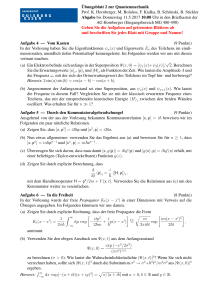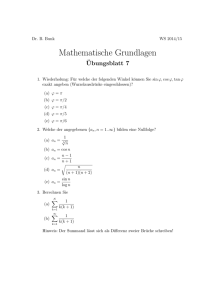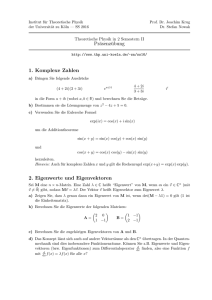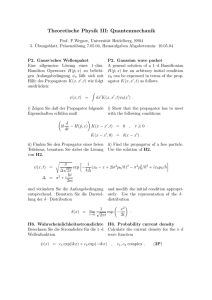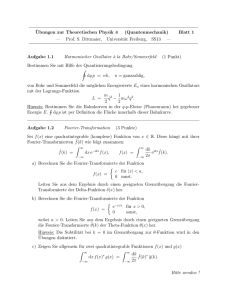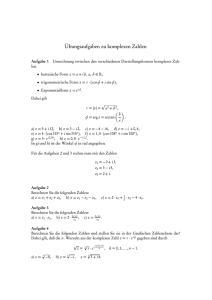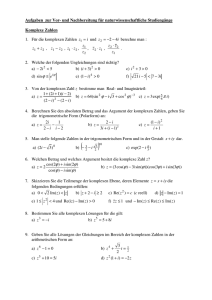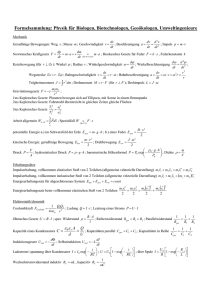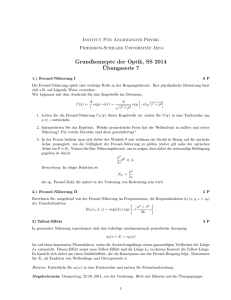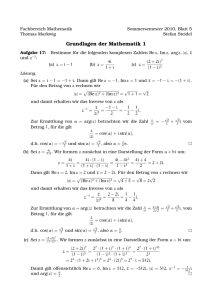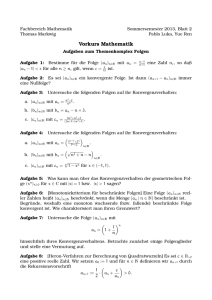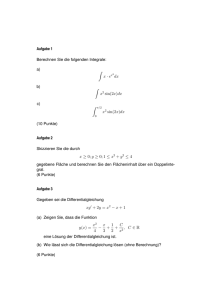12th sheet
Werbung
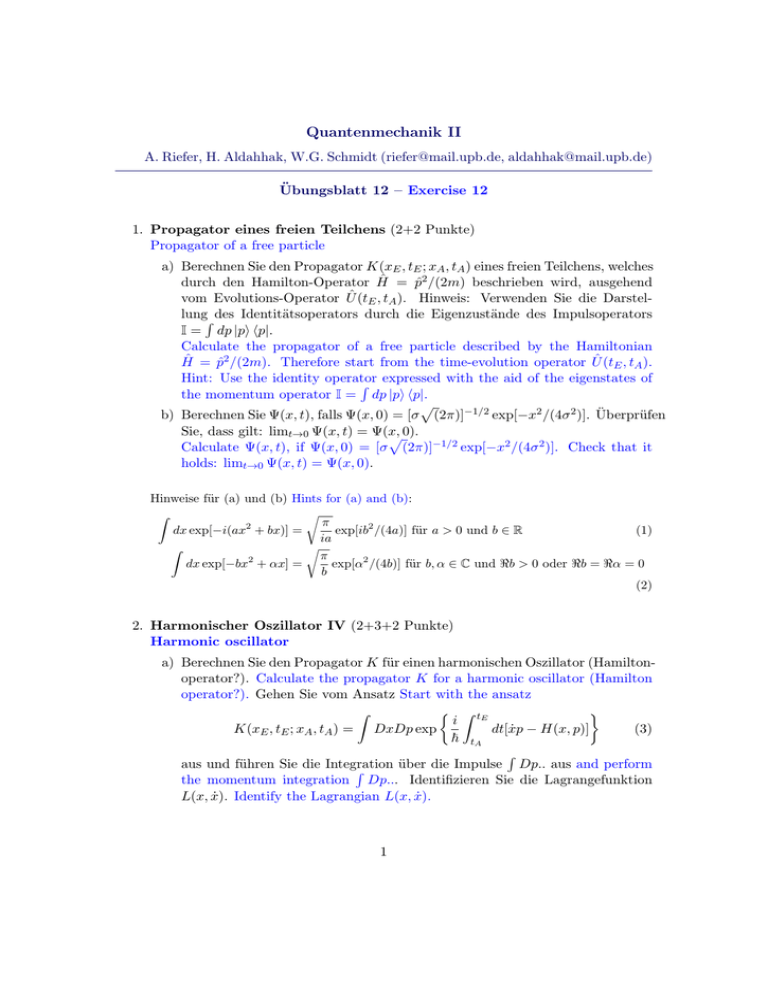
Quantenmechanik II A. Riefer, H. Aldahhak, W.G. Schmidt ([email protected], [email protected]) Übungsblatt 12 – Exercise 12 1. Propagator eines freien Teilchens (2+2 Punkte) Propagator of a free particle a) Berechnen Sie den Propagator K(xE , tE ; xA , tA ) eines freien Teilchens, welches durch den Hamilton-Operator Ĥ = p̂2 /(2m) beschrieben wird, ausgehend vom Evolutions-Operator Û (tE , tA ). Hinweis: Verwenden Sie die DarstellungR des Identitätsoperators durch die Eigenzustände des Impulsoperators I = dp |pi hp|. Calculate the propagator of a free particle described by the Hamiltonian Ĥ = p̂2 /(2m). Therefore start from the time-evolution operator Û (tE , tA ). Hint: Use the identity operator R expressed with the aid of the eigenstates of the momentum operator I = dp |pi hp|. p b) Berechnen Sie Ψ(x, t), falls Ψ(x, 0) = [σ (2π)]−1/2 exp[−x2 /(4σ 2 )]. Überprüfen Sie, dass gilt: limt→0 Ψ(x, t) = Ψ(x, p0). Calculate Ψ(x, t), if Ψ(x, 0) = [σ (2π)]−1/2 exp[−x2 /(4σ 2 )]. Check that it holds: limt→0 Ψ(x, t) = Ψ(x, 0). Hinweise für (a) und (b) Hints for (a) and (b): r Z π 2 dx exp[−i(ax + bx)] = exp[ib2 /(4a)] für a > 0 und b ∈ R (1) ia r Z π dx exp[−bx2 + αx] = exp[α2 /(4b)] für b, α ∈ C und <b > 0 oder <b = <α = 0 b (2) 2. Harmonischer Oszillator IV (2+3+2 Punkte) Harmonic oscillator a) Berechnen Sie den Propagator K für einen harmonischen Oszillator (Hamiltonoperator?). Calculate the propagator K for a harmonic oscillator (Hamilton operator?). Gehen Sie vom Ansatz Start with the ansatz Z tE Z i K(xE , tE ; xA , tA ) = DxDp exp dt[ẋp − H(x, p)] (3) ~ tA R aus und führen Sie die Integration über die Impulse Dp.. aus and perform R the momentum integration Dp... Identifizieren Sie die Lagrangefunktion L(x, ẋ). Identify the Lagrangian L(x, ẋ). 1 b) Die Koordinate x wird nun zerlegt in The coordinate x is now decomposed x(t) = xc (t) + X(t), (4) wobei xc (t) die klassische Bahnkurve eines Teilchens bezeichnet und X(t) quantenmechanische Fluktuationen darstellt. where xc (t) is the classical trajectory and X(t) are quantum mechanical fluctuations. Berechnen Sie zunächst die klassische Bahnkurve des Teilchens. Dazu müssen Sie eine Gleichung verwenden, die die Wirkung Calculate the classical trajectory of the particle. Therefore you have to use an equation, which minimizes the action Z tE S[x] = dtL(x, ẋ) (5) tA minimiert. Wegen der Definition von xc (t) und X(t) gelten zusätzlich die Randbedingungen: Due to the definition of xc (t) and X(t) additionally the boundary conditions hold: xc (tA ) = xA und xc (tE ) = xE (6) X(tA ) = 0 und X(tE ) = 0 (7) Einige Hinweise: Führen Sie zur Lösung der entstandenen DGL. eine neue Zeitkoordinate ein t̃ := t − tA und werten Sie die Randbedingungen aus. Verwenden Sie einen geeigneten Ansatz. Sie können das Additionstheorem verwenden: sin(x − y) = sin(x) cos(y) − cos(x) sin(y). Some hints: For the solution of the resulting ODE introduce a new time coordinate t̃ := t − tA and evaluate the boundary conditions. Use a suitable ansatz. You can use the addition theorem: sin(x − y) = sin(x) cos(y) − cos(x) sin(y). c) Zeigen Sie nun, dass S[x] geschrieben werden kann als: Now show that S[x] can be written as: Z tE Z tE m 2 m 2 2 dt (ẋc − ω xc ) + S[x] = dt (Ẋ 2 − ω 2 X 2 ) =: Sc [x] + SF [x]. (8) 2 2 tA tA Dazu müssen Sie geeignete Summanden in L(x, ẋ) partiell integrieren und die Randbedingungen sowie die Differential-Gleichung aus (b) verwenden. Therefore one has to perform an integration by parts in the Lagrangian L(x, ẋ) and to use the boundary conditions as well as the differential equation in (b). 2 Zusammenfassend lässt sich der Propagator K als Produkt aus einem ”klassischen Anteil” und einer Phase (Fluktuationen) schreiben: Finally one can write the propagator K as a composition of a ”classical part” and a phase factor (fluctuations): i K(xE , tE ; xA , tA ) = exp Sc [x] φ(tE − tA ), (9) ~ wobei für Sc gilt: where Sc is given by: Sc = 2 mω (xE + x2A ) cos[ω(tE − tA )] − 2xE xA . 2 sin[ω(tE − tA )] 3 (10)
